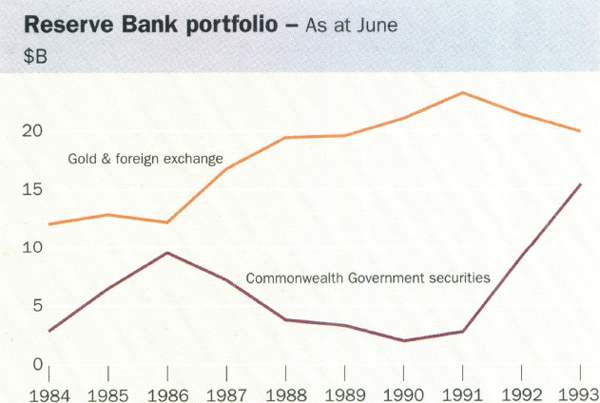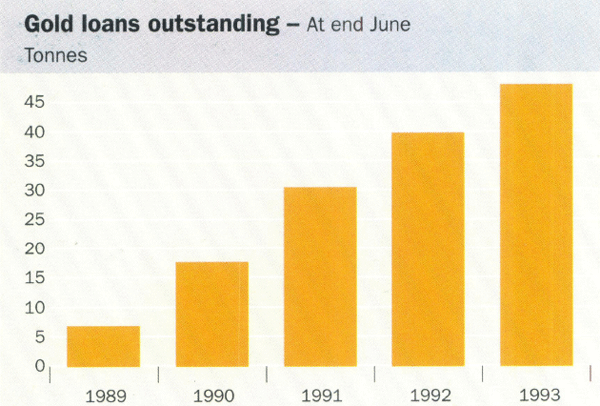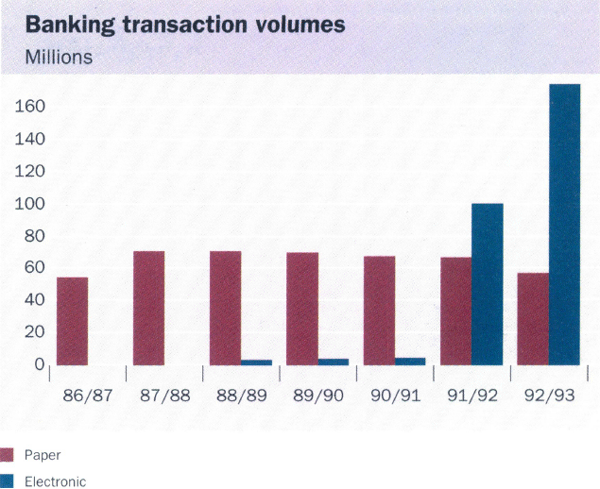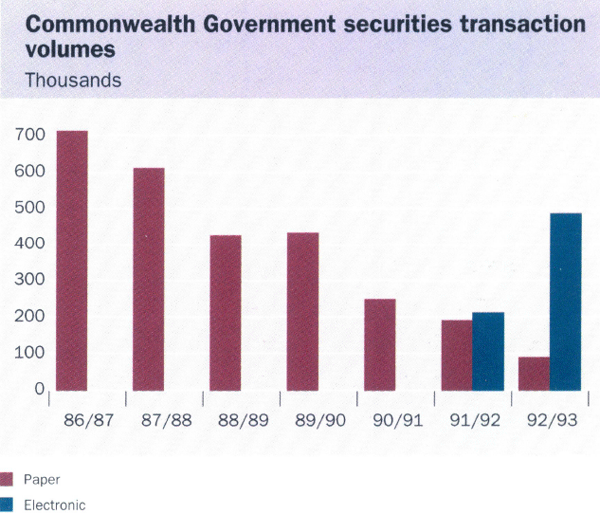Reserve Bank of Australia Annual Report – 1993 Reserve Bank Earnings and Operations
Earnings
The Bank's operations are directed primarily at economic and banking policy objectives, rather than profit maximisation. In most years, however, the Bank earns substantial profits, partly as a by-product of its policy operations. Over the past decade, the Bank has earned profits of more than $20 billion.
The underlying source of profits is the large margin of interest received on assets over interest paid on liabilities (the latter includes currency notes on issue, on which no interest is paid). Holdings of assets consist almost entirely of Commonwealth Government securities (CGS) and gold and foreign exchange (GFE). The foreign exchange component of GFE is held mainly in the form of securities of foreign governments denominated in foreign currencies. Underlying earnings depend, therefore, mainly on the level of interest rates in Australia and abroad, and on the size of the Bank's balance sheet. These earnings have grown over the past decade as the balance sheet has grown with relatively limited variability from year to year.
|
Underlying earnings |
Realised gains & losses* |
Net operating earnings |
|
|---|---|---|---|
| 1983/84 | 983 | 44 | 1,027 |
| 1984/85 | 1,122 | 819 | 1,941 |
| 1985/86 | 1,292 | 1,371 | 2,663 |
| 1986/87 | 1,412 | 2,035 | 3,447 |
| 1987/88 | 1,508 | 18 | 1,526 |
| 1988/89 | 971 | −554 | 417 |
| 1989/90 | 1,248 | −153 | 1,095 |
| 1990/91 | 1,322 | 391 | 1,713 |
| 1991/92 | 1,516 | 1,038 | 2,554 |
| 1992/93 | 1,760 | 2,803 | 4,563 |
| Average | 1,313 | 782 | 2,095 |
| * Charges to provisions in the three years to 1989/90, when market values of investments and/or foreign exchange holdings fell below cost, are recorded here as capital losses. | |||
The other major component of profit consists of realised gains (and losses) on the disposal of assets, which can result from two sources. First, the capital values of the domestic and foreign securities in the Bank's portfolio change as interest rates change. When interest rates rise, for example, the value of the securities held is reduced; when interest rates fall, as they did during 1992/93, the value of securities rises. Secondly, the Australian-dollar value of foreign-currency denominated securities held in official reserve assets changes as the exchange rate changes. If the Australian dollar falls against the currency in which the security is denominated, the value of the security in Australian dollars rises. Transactions in these assets can result in substantial realised gains and losses which vary considerably from year to year. Over the past decade, the range has been from a loss of $554 million in 1988/89 to a record gain of $2,803 million in 1992/93. The latter outcome reflects the combination of falling domestic and foreign interest rates, and a depreciating Australian dollar. The same combination of events generated the large capital gains recorded in 1986/87.
The Bank's profits are ultimately the property of its owner, the Commonwealth Government. In line with international practice, profits are paid as a revenue item to the Commonwealth Budget, usually after some transfers have been made to various reserve funds which the Bank maintains to deal with certain contingencies. These reserves have been built up over recent years to the point where, with the transfers made from last year's exceptional earnings, they meet fully the target levels established by the Board.
| Distribution of Reserve Bank earnings | Actual payments to Commonwealth | |||||
|---|---|---|---|---|---|---|
| Net operating earnings |
Transfers to reserves |
Balance available for Commonwealth |
Final payment from previous year |
Interim payment from current year |
Total Payment |
|
| 1983/84 | 1,027 | 18 | 1,009 | 216 | 530 | 746 |
| 1984/85 | 1,941 | 346 | 1,595 | 479 | 535 | 1,014 |
| 1985/86 | 2,663 | 192 | 2,471 | 1,060 | 925 | 1,985 |
| 1986/87 | 3,447 | 793 | 2,654 | 1,546 | 1,055 | 2,601 |
| 1987/88 | 1,526 | 740 | 786 | 1,599 | 300 | 1,899 |
| 1988/89 | 417 | 277 | 140 | 486 | – | 486 |
| 1989/90 | 1,095 | 520 | 575 | 140 | 300 | 440 |
| 1990/91 | 1,713 | 210 | 1,503 | 275 | 400 | 675 |
| 1991/92 | 2,554 | 200 | 2,354 | 1,103 | 400 | 1,503 |
| 1992/93 | 4,563 | 750 | 3,813 | 1,954 | 600 | 2,554 |
| 1993/94 | 3,213 | |||||
While the Bank has little control over the movements in interest and exchange rates which dominate the Bank's earnings in particular years, it does have direct managerial control over some of its revenues and costs, including through:
- the way it manages its portfolio of financial assets;
- the terms on which it provides services to its customers; and
- its control over its operating costs.
Management of financial assets
(a) General considerations The Bank holds assets, and transacts in them, primarily to facilitate the implementation of monetary policy. Within the constraints imposed by the primacy of those objectives, however, some discretion does exist to pursue actions which can increase the rate of return on the Bank's assets. On occasions, the economic policy and profit objectives will conflict – when, for example, a tightening of monetary policy raises interest rates and leads to capital losses on the Bank's portfolio of government securities – but on other occasions they will go hand in hand. Intervening with the objective of smoothing the exchange rate is an example of the latter as it involves buying Australian dollars when they are cheap (when the exchange rate is low) and selling them when they are more expensive (when the exchange rate has risen).
(b) Changes in the composition of the Bank's assets The composition of the Bank's assets as between domestic and foreign securities tends to change as a result of policy measures. In periods when the exchange rate is strong and rising, for example, the Bank will typically sell Australian dollars and buy foreign exchange. To “sterilise” the effects on domestic liquidity of selling Australian dollars, the Bank will sell domestic securities; as a result, the composition of its assets changes towards foreign securities and away from domestic securities (and vice versa). When buying or selling domestic securities, the Bank will usually have some discretion as to the nature of the transaction it enters into – whether it buys or sells outright, or under a repurchase agreement, and whether it transacts in short-term or long-term securities. When it is available, the Bank exercises this discretion so as to manage the expected profit and the risk of loss: it does this conservatively, and in a manner consistent with maintaining orderliness and liquidity in domestic securities markets.
Over recent years, when it has been buying Australian dollars, the Bank has had to make large net purchases of domestic securities. When bond yields were high and judged likely to fall, the Bank met a large part of this requirement through outright purchases of bonds, rather than purchases under resale agreements or buying short securities. This was consistent also with its objective of providing a steadying hand during occasional bouts of pessimism in the bond market. Overall, this approach has allowed the Bank to take on a greater exposure to bond yields and, in the event, to earn significant capital gains on its holdings of securities as yields fell.
The Bank exercises additional discretion over the composition of its assets through the use of foreign exchange swaps. If the Bank is selling foreign exchange outright, it needs to offset the potential squeeze on money markets by buying domestic securities. If those purchases are so large as to threaten to disrupt the market, an alternative is to use foreign exchange swaps. In this case, the sales of foreign currency are not finally delivered until some future, more convenient date. Foreign exchange swaps can be thought of as being repurchase agreements in foreign exchange.

(c) Investment of international reserves The area where the Bank has most freedom to pursue profits is in the management of its overseas assets – that is, the foreign securities and currencies in which official holdings of foreign exchange are invested. In these markets, the Bank operates mainly as an investor, and is unconstrained by domestic policy considerations.
As outlined in last year's Annual Report, the Bank has taken a more active role in managing its foreign investments in recent years. Within guidelines which reflect its need for liquidity and security, the Bank actively manages the foreign portfolio to enhance returns. This process involves decisions of the following kinds:
- adjustments to the currency composition of reserves to take advantage of expected exchange rate movements. These decisions are made largely on the basis of a medium to longer-term outlook and, consistent with our responsibilities as a central bank, holdings of individual currencies are adjusted infrequently;
- adjustments to the asset allocation among the major markets to take advantage of differences in expected returns – whether, for example, to hold more US or German government securities. (The use of foreign currency swaps and forward transactions means that currency and asset allocation decisions can be made separately; it is possible to have a high exposure to a country's bonds, without having a high exposure to its currency);
- adjustments to the duration of individual portfolios to take advantage of, or hedge against, expected changes in interest rates; and
- trading to take advantage of anomalies in the yield curve and to structure the portfolio in line with expected changes in the shape of the yield curve.
Consistent with best market practice, the Bank has established benchmarks against which it measures its performance. These benchmarks have been tailored specifically for the Bank to reflect its central bank responsibilities. The benchmarks cover the whole range of securities in which the Bank is willing to invest, and are structured in a way which balance, over the long term, the competing objectives of security, liquidity and return. They are designed to avoid systematic biases which would enable them to be easily outperformed; to outperform the benchmarks, managers must correctly predict the majority of interest rate and exchange rate movements.
The average durations of the portfolios comprising the benchmarks are 12 months for US dollars and 30 months for yen and deutschemarks. The shorter duration of the US portfolio reflects the fact that the US dollar is the main intervention currency, which makes the US portfolio more susceptible to fluctuations. Individual portfolios are weighted in the proportions of 40 per cent US dollars, and 30 per cent for both yen and marks.
The Bank manages its portfolio in a band around these benchmarks to allow scope to benefit from movements in interest rates and exchange rates. Duration is managed in a six-month band either side of the benchmarks. Currency and asset allocations are managed in a 20-percentage-point band either side of the benchmark weights. While this increases the scope to achieve higher returns, such as were achieved this year, it also increases the risks of under-performing the benchmarks (or, indeed, of making a loss) if interest rates or exchange rates move in unanticipated ways. All returns are measured on a mark-to-market basis.
The Bank uses the Special Drawing Right (SDR) as its unit of account in measuring returns on foreign investments, in contrast to private funds managers who generally use their domestic currency for this purpose. The latter approach, however, is not appropriate for a central bank, given that foreign reserves are held primarily to provide a capacity to intervene in the foreign exchange market. The SDR, which reflects the average movement of major world currencies, is more relevant in this regard.
The difference between actual and benchmark returns reflects the gains or losses arising from active management. During 1992/93, the return on holdings of foreign currency assets, measured in SDRs, was 16.3 per cent. The return on the benchmark portfolio would have been 11.6 per cent. This additional return over the benchmark was equivalent to about $A420 million and reflected four main decisions:
- holding long-duration positions, relative to the benchmark, for most of the year as interest rates fell;
- adopting an overweight position, on average, in yen and deutschemark securities, the two markets where yields fell the most;
- adopting an overweight position in yen around the middle of 1992, when the yen was relatively weak, and holding that position through most of the year as the yen strengthened; and
- adopting an underweight position in deutschemarks in mid 1992, when the mark was very strong, and holding that position as the mark weakened.
The currency and asset composition of foreign currency assets at 30 June 1993 was as follows:
| US dollars | Yen | European currencies | |
|---|---|---|---|
| By currency (Per cent) | 58 | 29 | 13 |
| By asset (Per cent) | 32 | 33 | 35 |
(d) Gold As part of Australia's international reserves, the Bank holds approximately 250 tonnes of gold, worth around $4.4 billion at 30 June 1993. Over recent years the Bank has increased the amount of gold it is prepared to lend to selected counterparties on a fully secured basis. At the end of 1992/93 48 tonnes were on loan to nine separate counterparties. Earnings from these loans amounted to $5.6 million in 1992/93, compared with $3 million in the previous year.

Customer services
Through its capital-city network, the Bank provides banking, registry, and note issue and cash distribution services. It seeks to cover the costs of providing banking, registry, and some specialised cash distribution services through fees and charges. It does not charge for note issue or for cash processing and wholesale distribution. Note issue, by its nature, generates considerable profit to the Bank, as notes are sold to banks at full face value, while cash processing and wholesale distribution are regarded as public goods, and provided free of charge.
In each of these areas, but particularly banking and registry, technological change has been rapid over the past decade: staff numbers have fallen, investment in automatic data processing has increased and the volume of transactions has risen.
(a) Banking services Specialised banking services are provided to the Commonwealth Government, several State Governments and government instrumentalities, and a number of overseas official institutions. The principal customer is the Commonwealth Government, and its departments. In addition to operating their bank accounts, the Bank assists these bodies where possible to improve their cash management techniques, particularly their payment and collection systems. To this end, the Bank has collaborated closely with the Australian Taxation Office (ATO) on its Billpay Mail Payments Project, which will centralise the collection of taxation payments forwarded through the post in five ATO locations; the first location commenced operations in June 1993. During 1992/93 the Department of Veterans' Affairs joined the Departments of Finance and Social Security as a user of the Bank's Government Direct Entry System (GDES), which gathers data from various government agencies, and sorts and electronically distributes payments to a wide range of financial institutions.
Some 174 million electronic banking transactions were processed in 1992/93, compared with 100 million in 1991/92. At the same time, cheque and non-electronic transactions declined to 57 million items, 10 million fewer than in the previous year. ReserveLink, the PC-based banking package designed to meet the specialised banking needs of the Bank's public sector customers, continued to expand during 1992/93. The package allows customers to perform a range of banking and related tasks from their own offices. It now has 40 customers, compared with 11 in 1991/92.
(b) Registry and settlement services The principal user of the Bank's registry services is the Commonwealth Government but other customers include the New South Wales Treasury Corporation, South Australian Financing Authority, Western Australia Treasury Corporation, Australian National Railways and a number of overseas organisations which have issued Australian-dollar denominated securities. The registry work for the Commonwealth Government continues to wind down as the remaining series of Australian Savings Bonds mature and as electronic transfers of securities replace traditional registry operations in the professional market.
Membership and use of the Reserve Bank Information and Transfer System (RITS) has grown to the point where it now has 116 users and accounts for 90 per cent of turnover in the professional market. A new facility based on RITS is being developed to permit members to lodge bids electronically at tenders for Commonwealth Government securities. The RITS system also provides the mechanism which allows banks to settle their interbank obligations through Exchange Settlement Accounts at the Reserve Bank at 9.00 am on the day following clearances.

(c) Note issue and cash distribution In 1992/93 the value of notes on issue grew by about 8 per cent, compared with 3 per cent in the preceding year, and the trend towards increased use of higher-denomination notes continued.

| At end June | $1 | $2 | $5 | $10 | $20 | $50 | $100 | Total | Increase (Per cent) |
|---|---|---|---|---|---|---|---|---|---|
| 1988 | 38 | 154 | 228 | 576 | 2,516 | 3,911 | 3,941 | 11,364 | 16.6 |
| 1989 | 36 | 54 | 241 | 643 | 2,554 | 4,037 | 4,781 | 12,346 | 8.6 |
| 1990 | 43 | 75 | 233 | 691 | 2,289 | 4,425 | 5,225 | 12,981 | 5.1 |
| 1991 | 43 | 73 | 249 | 679 | 2,048 | 5,345 | 6,356 | 14,793 | 14.0 |
| 1992 | 42 | 71 | 261 | 585 | 1,836 | 5,724 | 6,660 | 15,180 | 2.6 |
| 1993 | 42 | 70 | 297 | 591 | 1,813 | 6,284 | 7,269 | 16,367 | 7.8 |
Improvements to cash services during the year include a reduction from two days to half a day in lead times for most customers ordering currency notes. In some country areas larger reductions in delivery delays have been made. The Bank has also established a national standard of note fitness for reissue to the community, which is aimed at improving the quality of, and avoiding the premature destruction of, reissuable notes.
The Bank's administration and budget
(a) Staffing Staff numbers declined by a further 6 per cent (excluding Note Printing Australia) in 1992/93 in line with the Bank's ongoing adjustment of its structure to better align resources requirements with changing responsibilities. The cumulative decline in staff numbers since the peak in 1983 (again excluding NPA) was 42 per cent.
| End June | Head Office | Branches | Total excl. NPA | NPA |
|---|---|---|---|---|
| 1970 | 997 | 1,647 | 2,644 | 838 |
| 1975 | 1,169 | 1,808 | 2,977 | 775 |
| 1980 | 1,154 | 1,865 | 3,019 | 629 |
| 1983 | 1,243 | 1,931 | 3,174 | 653 |
| 1984 | 1,183 | 1,900 | 3,083 | 625 |
| 1985 | 1,175 | 1,839 | 3,014 | 585 |
| 1986 | 1,225 | 1,828 | 3,053 | 565 |
| 1987 | 1,152 | 1,726 | 2,878 | 552 |
| 1988 | 1,083 | 1,573 | 2,656 | 516 |
| 1989 | 1,015 | 1,286 | 2,301 | 487 |
| 1990 | 1,043 | 1,255 | 2,298 | 278 |
| 1991 | 1,012 | 1,197 | 2,209 | 283 |
| 1992 | 943 | 1,033 | 1,976 | 273 |
| 1993 | 913 | 935 | 1,848 | 273 |
The decline in numbers over the years reflects several factors, including:
- Changes in function, such as the abolition of Exchange Control and Rural Credits, and the winding down in Registries, partially offset by upgrading of the supervision and surveillance functions. Changes in function of these kinds are estimated to have accounted for about a third of the total reduction in staff over the past decade.
- Adoption of new technology, which has increased productivity in banking, trading and registry operations through such changes as GDES and RITS. Greater use of personal computers also has resulted in staffing economies in the “back offices” of the domestic and foreign dealing areas, and in word-processing.
- Moves to charge commercial rates for services, which have led to some cost-cutting, including staff reductions. In 1992/93 this led to the loss of most of the Queensland Government's banking business, necessitating further staff reductions at the Brisbane branch.
The reduction in staff numbers has been achieved through natural attrition, early retirements and voluntary redundancy offers (VROs). As the workforce has become smaller, it has tended to become more skilled, as the sophistication of the tasks performed at most levels and in most areas of the Bank has risen. To this end, additional resources have been devoted to training, and some specialists have been acquired from outside the Bank.
(b) Operating costs Excluding the lumpy expenditures on VROs, what might be called “underlying” operating costs have been flat in recent years, and staff costs have fallen.
| 87/88 | 88/89 | 89/90 | 90/91 | 91/92 | 92/93 | |
|---|---|---|---|---|---|---|
| Staff costs# | 118.9 | 115.2 | 118.0 | 117.8 | 116.4 | 112.3 |
| Other related costs* | 52.9 | 54.2 | 51.9 | 62.6 | 68.6 | 68.7 |
| “Underlying” operating costs | 171.8 | 169.4 | 169.9 | 180.4 | 185.0 | 181.0 |
| Cost of VROs | – | 33.1 | 22.3 | 3.7 | 18.8 | 2.7 |
| # Excludes VROs * Includes premises and equipment (including depreciation), but excludes IMF maintenance of value payment |
||||||
(c) Output “Output” is intrinsically difficult to measure in an institution which is orientated towards policy and service-related work, rather than straightforward processing or production-type tasks. In the former areas, quality is more important than quantity. While greater efforts than ever before are now being made to explain the Bank's monetary and banking policy actions, it is always difficult to measure the “quality” of policy advice. In some parts of the Bank, however, rough output measures can be made – for example, in the banking, registry and note issue areas. It is also possible to measure the amount of activity of the Bank's financial markets dealing areas by the number of transactions, although the value of such measures is more questionable.
The accompanying table presents some rough indicators of the growth in output in particular areas of the Bank over the past six years. Most suggest substantial increases in productivity, particularly when viewed in conjunction with the reduction in staff numbers. The largest gain is shown in banking transactions, where the introduction of direct entry processing through GDES has been the main factor.
| Currency, banking and registries | |
|---|---|
| 1. Notes handled | 20 |
| 2. Banking transactions (incl. GDES) | 332 |
| 3. Bank accounts maintained | 88 |
| 4. Registry transactions (incl. RITS) | 2 |
| Transactions in domestic and foreign markets | |
| 5. Foreign exchange transactions | 128 |
| 6. Transactions in foreign government securities | 192 |
| 7. Domestic market operations | 72 |
The minimal growth shown in registry transactions mainly reflects the phasing-out of ASBs; the number of transactions for bonds other than ASBs has risen sharply, with most of these now handled through the highly automated RITS, rather than through conventional registry transactions.